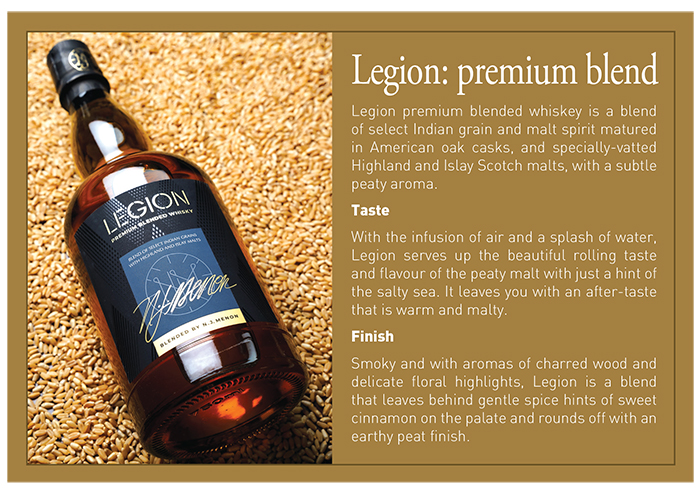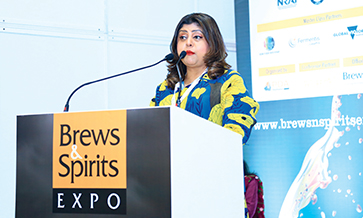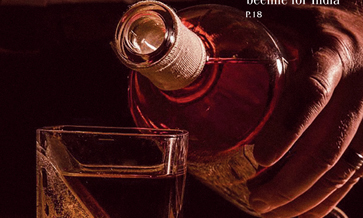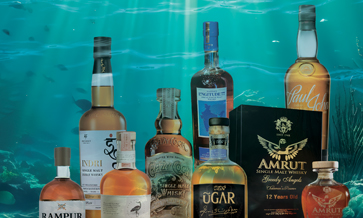After spending more than 60 years in the alcobev industry, Master Blender N. Janardana Menon (popularly known as NJM) puts his passion and experience into creating Legion, his own premium blended whiskey. We spent time with him recently, to understand his journey with celebrated production houses, his ‘happy coincidences’ in the profession, his stint as consultant to several other brands, and to try to unravel some of his secrets.
One wonders how many in the Indian alcobev industry could lay claim to the several “firsts” that NJM was a part of during his eventful tenure with McDowell & Co., a subsidiary of the UB Group:
- First Indian vodka in the mid-1960s (McDowell’s Red Czar);
- First Indian whiskey blended with Scotch (McDowell’s Coronation);
- First Indian flavoured vodka with lime, orange and pineapple (White Magic);
- First Indian gin ‘Duets’ with lime and orange (Blue Riband);
- First Indian single malt whiskey in 1993 (McDowell’s);
- India’s first ready-to-drink beverages: gin-n-lime, rum-n-cola;
- Largest selling whiskey brand in the world (Bagpiper).
When McDowell & Co., a Madras-based Scottish trading house, was bought by the late Vittal Mallya’s United Breweries in 1952, it was the beginning of a series of “happy coincidences” for a young NJM, who had only just completed his M.Sc. in chemistry.
Appointed as a chemist in 1958, NJM initially supervised the bottling of Bisquit Cognac and Dorville and Beehive brandies (also from France).
He says of his choice, “My family was initially reluctant about my working for a business trading in liquor. For them, a college lecturer’s job was a more honourable option.”
The second of his “happy coincidences” happened soon after. The first Communist party government in Kerala (1957) had decided to ease prohibition, and McDowell & Co. acquired a manufacturing licence. Happily for NJM, the local MLA insisted that the factory be set up in Cherthala, in Alappuzha district of Kerala.
This set off a flurry of activities to set up a new distillery, and NJM was packed off to earn his diploma in alcohol technology from the Harcourt Butler Technical University in Kanpur. He later also completed a diploma in brewing from the Siebel Institute of Technology in Chicago (US).

Culture & trends
In his experience with the industry, NJM has also travelled extensively around the world. I was curious to find out whether the culture around alcohol in the West is different, and how.
For NJM, what stands in stark contrast with India is the West’s scale of investments, their attention to maturation of spirits, and the near-fastidious nature of distilling and bottling. “Huge inventories of maturing spirits are locked up in cellars for years at the directions of their master blenders,” he says. “It is no child’s play.”
Different methods have been developed in the West to give their spirits – be it whiskies, brandies, rums, or even wines – character through maturation, mainly in wood. And these are so well-defined that Bourbon made in Kentucky has to undergo a minimum of 2 years in freshly charred American oak casks; but these very wooden barrels are never used a second time!
So far as maturing goes, NJM feels that a 12-year-old whiskey matured in India “might even be undrinkable” because of the warm climate here. “So we don’t have to blindly follow the West.”
In India, he rues the fixation with Scotch whisky. “Scotch still dominates as a status symbol, because of which we are missing out on several other categories of excellent spirits from India and abroad,” he says.
The prestige and premium brands in spirits are fast emerging as the growth sectors; these also offer the manufacturer better revenues. “Even the multi-nationals are now ‘rationalising’ their portfolios to weed out high-volume, low-margin brands. Attention is now being paid to the growing influence of premium spirits,” NJM says.
Indian manufacturers have a golden opportunity to rise and shine with good products and to build volumes amid better margins, he feels. “Paul John and Amrut distilleries have shown the world that India is maturing as a serious spirits supplier to the world,” NJM says. “Similarly, some craft gin brands have also broken the stranglehold of multi-national corporations.”
Nose for blends
What, according to NJM, are the essentials of blending spirits? How does the magic happen? A sharp and well-trained olfactory sense is a prerequisite to blending, he says.
“One needs to have a very good nose for identification of base spirits, be it from molasses, grain or other agricultural inputs,” he says. Assessing the quality and uniqueness of each spirit and its age also helps identify the ingredients and their geographical sources.
When planning blends, this knowledge assists in selecting the correct spirits. “In addition, understanding your client’s requirements and the market demands can raise blending to an art form,” NJM says.
Balance and uniqueness of the blend – and difficulty in duplicating it – become the hallmark of an accomplished master blender.
What about flavours? These have more to do with aroma than taste, NJM says. A high-end blend will not need added flavours – peat, wood, herbs or fruits – for the final blend.
“Only large-volume, low-margin drinks use artificial flavours,” he adds. Ready-to-drink beverages usually have chocolate, sherry, fruity, vanilla, oak or smoky flavours.
It is only in the final stages that blenders actually taste the spirit, to test the palate and finish. And what is the best way to do that? NJM prefers 20% dilution of the blend. “That is when all the aromas and taste come out best,” he says.
Legion story
Once a soldier, always a soldier: so goes the adage in the military. It applies equally to NJM – always on the lookout for opportunities to cook up magic to formulate innovative blends! After his retirement from the UB Group in 1999, NJM continued as a technical advisor until 2013, when Diageo acquired controlling shares in the business.
Not yet ready to hang up his boots, NJM emerged as a full-fledged consultant for distilleries across India – not only making blends for them but also advising on aspects of sourcing, production technology and operations.
In the years since, he has been instrumental in launching at least five brands that have gone on to sell in the millions of cases. Not far away was the lurking desire to launch his own brand, and so did NJM Blends take formal shape in 2018.
Although the venture is presently financed by NJM and his sons, they have partnered a distillery in Old Goa for production and bottling of the premier blended Legion whiskey. It retails for Rs 1,921 in Karnataka (750-ml bottle), Rs 700 in Daman and Rs 675 in Goa. Plans are afoot to launch it in other states.
Among the challenges that Legion faces now is its infancy – it still has to make its way past established brands to come to the discerning consumers’ notice. And that is not easy, Arun Menon, NJM’s son and one of the Directors tells us.
“The sky-high duties and entry fees demanded by many state governments is the first challenge. The second challenge is visibility in bars and clubs, where the managements demand steep discounts and difficult terms,” Arun says.
“Third, the established brands are very competitive with their offers in the market. As a boot-strapped venture, it becomes very challenging for us to make our presence felt,” he adds.
Baby steps
Even after McDowell’s distillery opened in 1960 (capacity 3,000 litres of perfumery-grade alcohol) the company continued to supply whiskey and brandy to local spirits wholesale merchants, and extra-neutral spirit to the newly-established Lakme Cosmetics and Shulton Inc. (Old Spice aftershave).
It was only in 1961 that NJM, McDowell’s first distiller-cum-blender at its plant in Kerala, brought out the company’s first brand: Golden Grape brandy. This was followed in quick succession by Old Bootlegger rum, Fine Old Malt whisky, Snowflake dry gin – and the hugely successful McDowell’s No. 1 brandy (1964).
McDowell’s No. 1 went on to raise the bar in the brandy, whiskey and rum categories as well, not only in India, but on foreign shores as well. But these products were initially restricted to South India, in particular markets in Madras, Bangalore, Hyderabad and Pondicherry.
The imposition of Emergency (1975-77) in India resulted in an unexpected windfall for the Alcobev sector in the country. The Centre relaxed its policies vis-à-vis prohibition and opened up a wide variety of distillery, brewery and distribution licences. Several entrepreneurs made a beeline for these and set up distilleries and breweries of varying capacities, predominantly in North India.
UB’s windfall
However, the atmosphere changed drastically for most of these businessmen when Morarji Desai, an avowed proponent of prohibition, formed the next elected government at the Centre and clamped down on the alcohol business.
NJM remembers, “Liquor was served only to foreign guests in star hotels. To others, it was often served surreptitiously by room service in teapots!”
He recounts: “Several investors in distilleries and breweries were at their wits’ end to make businesses succeed. Vittal Mallya saw the chance and lapped up many such manufacturing units across many states, at throwaway prices.”
Thus Kalyani Breweries (Kolkata), Sona Distilleries (Alwar, Rajasthan), Premier Breweries (Palakkad, Kerala) and Punjab Breweries (Ludhiana) were bought by the UB Group.
These acquisitions, along with Vittal Mallya’s earlier investments into three important trading houses – Phipson & Co. (Black Dog whiskey, Blue Riband gin), Carew & Co. (Gold Ribbon and Imperial whiskies) and Herbertsons & Co. (Bagpiper whiskey, Honeybee brandy) – finally gave the UB Group a firm foothold in North India.
According to NJM, “With these acquisitions, the UB Group became a pan-India company in terms of spirits production, bottling and distribution capacities. You must note, however, that Vittal Mallya ensured that all these entities competed against each other for market share for their respective brands, but under the UB umbrella.”
Technical centre
NJM had his early training under Dr. B.K. Jha, who was the Alcohol Technologist with the Uttar Pradesh government and was picked up by Vittal Mallya to head the Cherthala Distillery and technical lead of UB Group’s newly acquired and commissioned properties.
On Dr. Jha’s retirement in 1977, NJM was appointed Technical Director of UB Group at the age 40. NJM continued to operate from Cherthala, overseeing about 30 distilleries and breweries, commissioning new plants, evaluating companies for acquisition, maturing and distilling malts – and concocting new blends.
In 1988, NJM moved to Bangalore to set up a state-of-the-art Technical Centre in the city for training, testing and accelerating innovation. He also served as a member of the Carbonated Drinks and Alcoholic Beverages Committee of the Bureau of India Standards until his retirement in 1999.
Parting shot
Despite the challenges, Arun is gung-ho about the India story for alcoholic beverages. It is no longer only the multi-nationals, Arun says. “The likes of Amrut and Paul John distilleries have raised awareness and expectations with their superior products. Now being an Indian brand no longer means a sub-par product!”
What are their favourite drinks? And their favourite watering holes? For Arun, it is craft beer from Toit Pub and Bier Library in Bengaluru. In Goa, where he spends a good amount of time, it is Jospeh’s Bar, or Down The Road in Panaji.
He counts among his favourite spirits Paul John’s Edited whiskey, NJM’s own Legion blend, and Black&White Scotch whisky – not necessarily in that order!
NJM is also not much of a bar-crawler. But he fondly remembers the weekend open-air markets in Edinburg, Scotland, where he partook of good Scotch, food and the sights and sounds of the festive occasion.
He prefers whiskies that are smoky and smooth – but not necessarily single malts. He prefers his blended whiskies with soda. And he loves the occasional mid-day Martini. Cheers to that!

NJM is always on the lookout for opportunities to cook up magic and formulate innovative blends.













